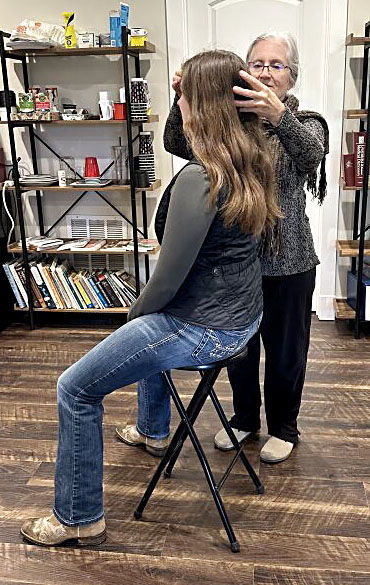Aging is a fact of life. The Alexander Technique can help practitioners move with more ease and safety so that they may age gracefully.
Debbie Romero of Optimal Posture in Front Royal uses the practice to help clients discover the habits that may be causing them discomfort and explore new ways of movement.
Developed in the 1890s by Australian actor and teacher Fredrick Matthias Alexander, the practice is a culmination of Alexander’s self-exploration and experimentation with head, neck and spine positioning as he sought to alleviate his chronic voice problems.
Alexander discovered that improved direction of the head, neck and back worked as what he called a primary control — an overarching influence — over all the systems of the body, as well as psychological processes.
“The Alexander Technique can make anybody do anything better,” Romero said. By bringing awareness to the spine, the Alexander Technique is both a diagnostic tool and a means to bring about improvement in use of the body.
Romero became an orthopedic massage therapist in 2000, specializing in soft tissue rehab.
“About 10 years into that, I noticed that I could help people on my table, but as soon as they went back into their daily activities, they were coming back with the same issues,” she said, adding that she was introduced to the Alexander Technique by a friend. “I thought, ‘oh yeah, this is the best of the best that I can come up with right now.”
She graduated from Alexander school in 2014 — a three-year, 1,700-hour commitment — and now she interweaves “whatever is needed from my knowledge base” to first take clients out of pain and then work with them on rethinking the daily movements that may be contributing to the discomfort.
“As we age, we start to form maybe not so good habits of the way we do simple things every day,” Romero said, noting that, for instance, she finds herself wanting to look down at her feet as she walks. “As we age, we are losing the ability of our kinesthesia, of staying in touch with being in touch with things, instead of just being visual.”
Romero said that while habits can be helpful in some instances, there is value in examining the ways in which we move to explore more easeful approaches.
“The Alexander Technique really helps you find your habitual use and gives you some different tools to change those. I tell people to just find some path in your day that you do several times a day and that’s where you practice. You can practice it in your daily activities,” she said.
Romero said she also works with clients to help them avoid reactionary movements, encouraging them instead to pause before acting.
“We’re trying to interrupt the reaction. We think about it when we’re lifting something heavy. We’re always conscious of ‘oh, I better have really good use when I do this so I don’t hurt myself,’ but we don’t realize the micro units of dysfunction that are going on during our day,” she said. “The pause is critical. It’s pausing and being curious enough to find a different way to do it that’s healthy. It might be as simple as ‘boy I really have to remind myself as I age not to look down when I walk. To stay up here and be more kinesthetic and feel what's under my feet. That’s a big one and that takes slowing down.”
Romero explained that looking down when you walk can be dangerous because it can lead to falls. She said that when we walk with a fear of falling, the nervous system sends a message to the body that “things aren’t quite right. And we get that subconsciously. It can go through the whole body and cause us to startle, to stress or have too much tone therefore we start to stiffen. Once that stiffening comes, we’ve already set ourselves up for a fall.”
Instead, the Alexander Technique encourages smooth joint movement and keeping your head up to keep peripheral vision available. “That’s a big one so you don’t get that tunnel vision of looking down,” she said.
Romero said that most clients come to her after experiencing “some sort of interruption — whether it’s pain or a fall — some sort of event that’s their wake-up call. Or they’ve been through the traditional side of medicine and are not getting the help they need.”
While she serves all ages, she said that most of the clients she sees in the office are seniors. She also works with equestrians, preferring to work with riders first off the horse and then work with horse and rider together on-site at area farms.
For more information, visit www.optimalposture.org.


(0) comments
Welcome to the discussion.
Log In
We will consider two submissions per writer per month. Letters: 250 or fewer words. Commentaries: Under 500 words. You may submit a photo with a Commentary if you like. Email submissions to news@nvdaily.com.